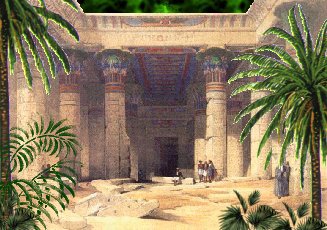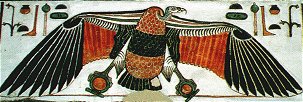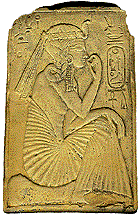|
|
|
|
|
  "She of Nekheb"   PEERING into the lush gardens surrounding the Temple, the young priests are overwhelmed by the beauty and tranquility that greets them. They are expectant and thrilled at being chosen to serve here. Quickly they begin gathering all they need for today's festivities: the fragrant blooms of the sacred lotus for decoration, succulent meats and cheeses, fine breads oh...and they certainly can't forget the wonderful jugs of hearty , delicious wines. Today is going to be a most auspicious occasion. The newly built Temple to the great Goddess Nekhbet has just been completed and all are welcome to come honor and celebrate. COME with me now and let us explore this sacred and elegant Temple in the glorious city of Nekheb and learn much about the great Goddess Nekhbet.  NEKHBET, "She of Nekheb," is the Vulture Netjer associated with both the land of Upper Kemet itself and its protection, and the protection and symbolism of the White Crown (Hedjet). Nekhbet is often depicted as a full vulture flying over the head of the ruler bearing the feather of Ma'at and a shen, the circular symbol for eternity grasped in her claws. On depictions of the Udjat, she is often accompanied by Wadjet, the cobra Netjer of the North, and symbolizes one half of the Two Lands which make up Kemet politically. Her head was mounted on the nemes headdress of rulers alongside Wadjet's uraeus or cobra head (witness the beautiful vulture on the forehead of King Tutankhamun's funerary mask), and a vulture headdress was worn by the chief queen/consort from the New Kingdom forward, identifying her both with Nekhbet and with Mut of Uaset. PER-WER was the shrine of Nekhbet, the vulture Goddess of southern(Upper) Egypt at the beginning of Egyptian civilization. The city of El-Kab (or Nekheb) honored the Goddess Nekhbet, who was represented by a white vulture perched on three lilies or three stylized lotus flowers. She holds in her claws the insignia of royalty, recalling the ancient period when the south was an independent kingdom fighting with the kingdom of the North. IN EGYPTIAN ANTIQUITY, Nekhbet was invoked under the name of the Goddess "Shetat." Locally, she was considered to be a creation Goddess, who created the world pronouncing seven words and launching seven arrows. Remember that Isis will also take the aspect of a vulture to fly over the dead body of Osiris and spiritually impregnate him. Nekhbet is also equated with the Greek Eileithyia, Goddess of childbirth and would appear to fit snugly into the category of supernaturals, who were simply primitive personifications of ideas or principles. ICONOGRAPHICALLY, the Goddess is often shown with wings spread, grasping the symbols of eternity in her claws. She also appears as a vulture at rest in statuary or as an element in one of the king's titles. With one wing outstretched before her she is a protective symbol carved above royal or ritual scenes. She was also recognized as one of the "two Mighty Ones", the tutelary Goddesses of the kingdoms united into one state around 3000 BC.  IMPORTANT EPITHETS for the understanding of the nature of Nekhbet can be gleaned from the Pyramid Texts. The king's mother is named as the "Great White Cow" who dwells in Nekheb and possesses hanging breasts. Here the allusion is to Nekhbet as a mother Goddess for which the cow imagery is traditional in Egyptian thought. In royal birth scenes Nekhbet takes the role of protective nurse to the monarch. She can even take the serpent form of the northern Goddess, normally to form an heraldic device around the sun disk or royal name. HER CULT SANCTUARY at El-Kab is impressive in size but devastated. The presence of a Middle Kingdom shrine is attested as are constructions from Dynasty XVIII, but the present ruins date to the last native rulers, Dynasties XXIX-XXX.  
A Few Passages From |